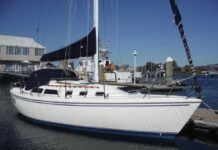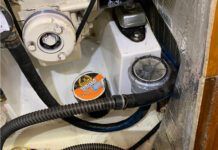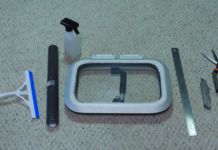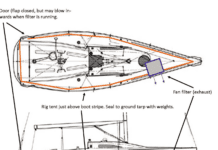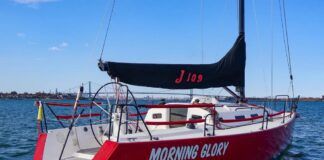Wheel steering or tiller? If theres an option, which should you choose? Which is better?
Wheel steering once was for large yachts and big ships.
The oldest restored warship in the world, the Swedish Wasa, built in 1628, had wheel steering.
And Nelsons H.M.S. Victory had twin wheels with the manila tiller hawser wound on the hub between them. Sometimes, it took four helmsmen to enable the real-life Horatio Hornblower to cross the T.
The J-Class boats, the Americas Cup giants of the 1930s, had wheel steering (and immediately to mind come names like Herreshoff, Charlie Barr, J.P. Morgan, Lord Dunraven, Fife and Thomas Lipton, probably the worlds most popular loser), as did the 12-Meter boats that (via the likes of Ted Turner, Baron Bich, Ted Hood, Allan Bond and Ben Lexcen) brought the resurrected Americas Cup to the masses…or at least produced a following larger than the cheering section at the croquet nationals.
For ships and big yachts, wheel steering produces a compact mechanical advantage preferable to a simple, deck-sweeping lever. On big, beamy old Dutch barges with barn-door rudders tillers are so long the helmsman literally takes a hike to come about.
Perhaps it was the 12-Meter boats that, about 25 years ago, caused wheel steering to become the rage on sailboats, even those ranging down in length to 26 feet or so.
The Tiller Strikes Back
Despite the proliferation of wheel-steering for small sailboats, the traditional tiller is making a comeback.
Tillers always have been the choice for small-boat racing, catboats and multihulls.
But now, tillers are found on the popular J-Boats, the vigorously-raced Mumm 36s, the big round-the-world single-handed racers like Cray Valley and many cruising boats that use auto-steering devices…or know how, with a bit of surgical tubing and a couple of blocks, to make almost any boat self-steering.
Tillers have some advantages. They are quick, virtually foolproof and visually obvious as to whether the rudder is amidships, hard-over or in-between. No king spoke, fancy ropework, counting turns or checking the quadrant, cable or worm is needed.
A rudder position indicator coupled to a wheel is great when backing down or theres nothing but a zephyr, but they are rarely fitted to small boats. They still are made, however-electronic versions by Autohelm (800/539-5539) and Vetus Den Ouden (410/712-0740) and a mechanical type by Summer Equipment in Vancouver, B.C. (604/873-4545).
Theres nothing quite so reassuring as a big outboard rudder hung on heavy gudgeons and pintles, connected via a stout rudder head to a tiller with which you could pry loose Plymouth Rock. Not only is the rudder extremely effective, the whole works can be easily inspected with a stretch of the neck.
For the purist, a tiller also provides that heralded feel which tells you if the boat is making way gracefully or is struggling-constantly falling off or griping. However, be careful backing down; unless you keep the tiller close to amidships, that feel can alter your orientation.
A Tiller Needs Help
To give a helmsman more choices about where to plant his weight-as ballast, for good visibility or just for plain old comfort-a tiller usually needs an extension.
Whether called a tiller extension or a hiking stick, what a techy might call an athwartships facilitator should have a universal joint and a good handle. One marine dictionary in our library says tiller extension is a British term and hiking stick is US. Others say the terms are interchangeable.
For clarity, perhaps PS readers will not mind if, for this evaluation, we very arbitrarily say hiking stick for the slender ones generally used on small boats and tiller extension for the more robust versions, most of which have ladder handles.
Practical Sailor gathered up 16 of them for a close examination. Several are brand new on the market. All are slicker than the hiking stick we once made of an old laminated wood Slazenger tennis racquet. (We also once crewed on a Great Lakes Mackinaw Race boat that had wheel steering but used a custom-made, clamp-on hiking stick on the wheel rim.)
The method of attaching them to tillers varies considerably, and thats vital-because the joint will get extraordinary wear. Also of interest is the manner in which the stick or extension is prevented from dropping below horizontal. Still another consideration is a means of snap-stowing the device along the tiller when not being used, to prevent it from flopping around and perhaps getting jammed in a corner, as surely will happen when most disastrous. (Those with a ball on the end have even been known to grab a cockpit combing.) A final thought: Do you want it to demount for stowage?
The tiller extension competition is international, with one US manufacturer (Forespar), two British (Spinlock and RWO), one Australian (Ronstan) and one French (Wichard). A third British maker, Barton, has a US distributor that does not stock the companys tiller extensions. There also are a few long hiking sticks-GRP Arribas and aluminum Silver Sticks-in the catalog published by Murrays, a California firm that caters to fast catamaran owners.
The Joint
With almost any brand of tiller extension you prefer, the manner in which the joint is attached to the tiller is a choice .
There is a good range of joints, which must swivel 360 in a hemisphere above the tiller.
The simplest and cheapest is an elastic joint (rubber, urethane or elastomeric polymer) that tends to make the tiller, when not in hand, stand straight up or wave around in a generally vertical position. Its there for the grabbing; one usually feels for it near the tiller end. The elastomer versions claim to be good for millions of bends before failing. RWO even offers two densities of the elastomer to provide more or less flexibility.
Next comes a stainless steel universal joint, a U-shaped hinge on a base with a post. Theres a hang-up point, but its rarely a bother. These two-hinge-post joints will outlast the wood into which are driven the customary two mounting screws (bolts are better).
Finally, there are, mostly on the more robust tiller extensions, the double-U joints; one with adjustable tension to make it stay where you last left it; the post-and-socket types; and several ball joints, all of which usually have one or more through-bolts.
A further refinement is the means used, usually an elastic pad or collar, to prevent the stick from dropping much below a horizontal position, where it can jam up against a coaming or a corner of a seat. The ideal is full-unfettered articulation through a hemisphere.
The Grip?
As with the optional joints, there is on most of the straight sticks a choice of grip.
Dubbed variously by the manufacturers as straight, button, ball or golf (a tapered shape), the grip usually has urethane foam padding.
The foam wont last forever, but as is well-known by owners of boats steered with metal wheels, there are many days when its not pleasant to hang onto cold bare metal.
However, the foam is primarily to provide the secure grip needed to handle any tiller-steered boat.
Some makers use quite soft foam; others use very hard foam. It seems likely that the harder stuff will last longer. However, the softer foam will be appreciated if the tiller and extension, when not in hand, decide to do something downright vicious.
One manufacturer, Wichard, uses a closely woven fabric cover over the foam. Its a quality touch.
Three of the four sturdier tiller extensions-the ones with what are called ladder grips-have hard plastic grips.
Fixed Length Sticks
Getting to work now on the collection, perhaps the first consideration is whether to have a simple fixed-length hiking stick or one whose reach can be varied-quickly and easily while underway.
The fixed-length sticks, starting for as little as $25 or $30, are generally the cheapest way to go. Forespars very serviceable Swivel Stick, a black anodized aluminum tube with a foam-ball grip and an elastomer joint, is an example. Others are Ronstans X-10 fixed, RWOs Fastac and several new blue and white models from Wichard.
The fixed-length aluminum sticks usually come in several sizes, with optional swivels and grips.
Choosing between an elastic joint and one of several metal swivels is a matter of preference.
If you don’t trust the trendy, thin, black-anodized aluminum tubes, there are fatter tubular models and even stronger sticks of man-made materials. Various sizes and even do-it-yourself cut-to-length-and-glue models are included in the more exotic straight sticks, whose prices get up around $100 or more.
Included in these premium versions are Ronstans Battlestik, a carbon fiber/Kevlar extension that can set you back $145; RWOs carbon fiber/GRP Carbo Stik, another hot-dog stick that lists for $85; Forespars Ultimate Graphite for $65, and Forespars husky carbon fiber/Kevlar Cobra, whose price ranges from $78 to $165.
These and all other prices stated and shown on the chart are retail list. Most are discounted close to 20% by marine catalogs.
Twist Locks
In between the simple, light, straight hiking sticks are twist-lock adjustables.
We found but two makes-Forespar and Ronstan.
Forespar, one of the worlds premier makers of poles, has a white-powder-coated aluminum stick in several sizes, with either a quick-release swivel that is first class or the patented StaFAST joint mentioned above. It has a good foam grip plus a foam ball.
Ronstan sells three sizes of its black anodized aluminum X-10 extendibles with several grip options and either elastomeric or stainless steel joints.
It has been reported to Practical Sailor that twist-lock sticks do not enjoy an enviable reputation because, like twist-lock boat poles, they sooner or later fail. One veteran small-boat sailor said he gave them up in favor of a stick made from an old golf club. We forgot to ask whether he used an iron or wood-probably a putter.
Twist-locks should never be lubricated. If we were to use one on a boat, wed make sure it was demountable and stowed in a protected place when not in use-to prevent the accumulation of dirt, salt and other crud that is bad for any twist-lock joint. Considering the options, twist-lock does not seem the best way to go with something that gets the continual stress involved with steering a boat.
Ladder and Saddle Grips
Although theres no reason (except price) that they can’t be used on small boats and on cruising boats of any size, the powerful ladder and saddle grip tiller extensions generally are seen on powerhouse racers.
The eight in our collection run in price from $86 up close to $300.
The manufacturers make them brutally strong and seem to concentrate on comfortable grips on which the helmsman can use two hands, when needed. Also important, the tiller extensions for larger boats are, with one exception, extendible.
Ronstans X-10 ladder extension comes in two fixed lengths and has a three-step ladder for gripping at different lengths. The black-anodized aluminum shaft is fluted for extra strength. The fairly hard Hyperlon on the three handle positions feels like it would last a long time. For the money, this simple Australian product is a lot of tiller extension.
The very new Wichard comes in two sizes, is moderately priced, has a comfortable molded saddle handle, plus a nice intermediate foam grip. The one-finger trigger, cleverly recessed in a crescent in the handle, works stainless steel stop pins. Both parts of the arm are powder-coated and it seems likely that the paint on the smaller one will get worn and a bit unsightly. It comes with but one simple swivel.
The old reliable (but with a newly designed handle and a great new joint option) is Forespars OceanRacer. Available to three extending ranges, this US-made tiller extension has stainless steel adjustment pins; the adjustment mechanism is rugged but a little balky (you might call it firm). The OceanRacer is available with Forespars new StaFAST joint, which can easily be adjusted to have just enough tension to stay put when temporarily released. Its moderately priced.
Somewhat similar (in that they use very modern, light materials) are the two British tiller extensions-RWOs Mighty Stik and the Spinlock, a new design that uses a common shaft, many joint options and interchangeable handles to produce a range of extensions.
RWOs Mighty Stik, with a trigger-finger extension mechanism with Torlon balls, is slick, the smoothest operating of the lot. It has a carbon-reinforced ball joint (they call it an Omniball) that rotates in any direction, has a rubber collar to preclude drooping and even has a push-button Quickpin for easy demounting. The Mighty Stik comes in four extendible ranges and two fixed-length models.
The new Spinlock tiller extension, available in four lengths, is a shaft system with three easily changed handles (one straight, one saddle and one asymmetrical saddle) and several stainless-steel-in-plastic-sleeve joints, all with two through-bolts (a good idea) and rubber cushions to prevent the handles from drooping. The extension mechanism is smooth, with push-button controls and Torlon balls.
The Bottom Line
Fixed-length tiller extensions made of aluminum tubing may well be adequate to the job. If price is important, any of the fixed-length models would do, as long as its equipped with whatever grip and swivel you prefer.
However, if youve ever seen aluminum tubing collapse when kinked even slightly, you might be, as are we, inclined to favor a straight stick made of sterner stuff-like carbon fiber, GRP or Kevlar. Among such sticks, we favor Forespars fat Cobra, for its modest weight and price, but even more because it looks indestructible. Wed prefer it equipped with the StaFAST swivel. (The one shown on the cover is elastomeric, which happens to have a push-button snap-off design that is the best of its type.)
However, unless we were still sailing a small one-design, the choice would be one of the extendible ladder/saddle models. The rugged, proven Forespar OceanRacer would get our vote if we were going to sea and absolute reliability ranked first. If it was coastal cruising, it would be tough to pass over RWOs very slick Mighty Stik with Omniball joint, but our choice is the new Spinlock, because of its excellent asymmetrical handle and the rubber-cushioned, stainless steel quick-release swivel.
Contacts- Barton/Imtra, 30 Samuel Barnet Blvd., New Bedford, MA 02745; 508/995-7000. Forespar, 22322 Gilberto, Rancho Santa Margarita, CA 92688; 949/858-8820. Murrays, Box 490, Carpinteria, CA 93014; 800/786-7245. Ronstan,7600 Bryan Dairy Rd. N., Largo, FL 33777; 727/545-1911. RWO, 3000 Park Way Industrial Dr., Buford, GA 30518; 770/945-0564. Spinlock, Maritime Supply, 42 Grandview Terrace, Essex, CT 06426; 860/767-0468. Wichard, 507 Hopmeadow, Simsbury, CT 06070; 860/658-2201.



